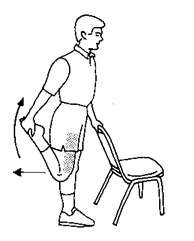Signs and symptoms like stiffness, or pain, often show up after the condition has been around for a while. At first you may not even be aware you have a problem. Seeing a professional like a Chiropractor for a proper examination including checking your ranges of motion for each joint is a great way to know for sure how much you need to stretch. We will then encourage you to start a stretching routine that can help prevent future problems.
Many people wait until they have some obvious symptom like pain or stiffness to start thinking about what they can do. Here’s how that works. Let’s say some of your back or hip muscles are tight even though you have no pain. You decide to clear the snow from your driveway or vacuum the house. Of course, you need to use these back and hip muscles for either of these tasks. Then, because the muscles are pulling tighter on the surrounding bones of your lower back, they can easily strain the joints or other muscles in the area. We’ll often hear, ‘I threw my back out on the first shovel full of snow!’ It is usually when you do a little more, or reach a little further, or lift something a little heavier than your usual routine requires. Better flexibility equals less strain and less pain.
When these people walk into our office, we check both the joints and the muscles. If the joint is restricted, it needs to be adjusted. We gently move the joint, quickly and painlessly to restore the normal range of motion and improve flexibility and reduce pain. If we also find the muscles are tight and sore around this joint, we need to release that muscle to stop it from pulling on the bones, either side of the sore joint and allow normal mobility without pain. After the adjustment you’ll feel looser, but, if the problem has been going on for a while, it may stiffen up very quickly, within a day after the adjustment. That’s why we need to repeat the treatment a day or two later. After an adjustment and muscle releasing, you may still be a little sore, and we recommend you use some ice to reduce the pain at home. If the ice doesn’t help and/or it is very stiff, you may benefit from moist heat as well. Here, you can take a hot shower or warm up a moist heat grain bag or a gel pack with a moist cloth around it. The moisture is important to allow the heat to penetrate.
The important thing is to get into a good stretching routine that can help you to prevent future strains and sprains. After you are as flexible as you should be, the next thing is to work on improving your strength. We all know that strengthening muscles can help prevent painful conditions. The main thing to consider when starting a strengthening program is to start out slowly with only a little weight and very gradually increase the amount of weight. You also need to keep checking your flexibility since increasing strength often causes a tightening of muscles. They actually grow in size from an increased demand on them, but they also tend to become a little shorter, so you need to stretch again.
All of our older patients, 80-year-old plus, are very diligent with their exercise, whether it is gardening, or yoga, water aerobics, or simply walking. Most also have found that regular stretching helps them prevent injuries and helps them stay feeling young. Who wouldn’t want that?



